|
My wife
and I attended the Congress, which was of interest to Marie for the
genealogical presentations and to me for the heraldry lectures. Last
held in 2006 at St. Andrews, Scotland, the Congress brings together both
genealogists and heraldists from around the world. The Quebec Congress
had representatives from Canada (mainly Quebec), Mexico, the United
States, United Kingdom (most from Scotland), Ireland, France, Belgium,
The Netherlands, Spain, Norway, Sweden, Finland, Germany, Switzerland,
Croatia, Iran, Russia, Australia, and South Africa.
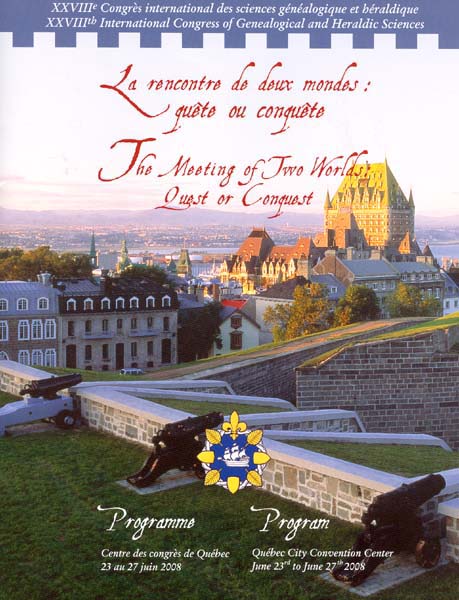
Quebec Program
The
official opening ceremony on Monday, June 23rd included Her
Excellency the Rt. Hon. Michaëlle Jean, Governor General of Canada, who
expressed her special interest in heraldry since being granted arms on
her appointment, and her surprise when her husband recently petitioned
Canadian Heraldic Authority for his own personal coat of arms, and had
just received his Letters Patent (which had to be signed by his wife)
just prior to the Quebec Congress.

The
opening ceremony included a group of dancers from the Huron Tribe, a
platoon of re-enactment soldiers representing New France, two pipers
from The 78th Fraser Highlanders Quebec City Garrison and an
actor in period costume portraying Samuel de Champlain, founder of
Quebec City in 1608, who served as commentator for the ceremony.
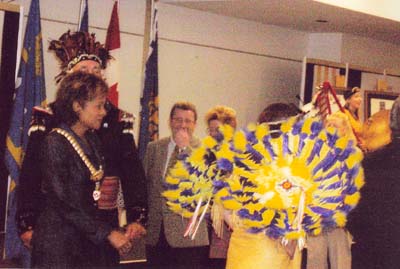

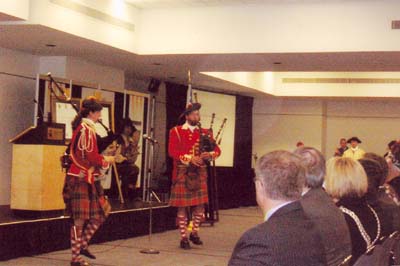
We
attended a party hosted by Mark Dennis and Alex and Hattie Findlater
from Scotland who had rented a house in Quebec City for the duration of
the Conference. Here is a sampling of photos.

Hattie
Findlater with Mrs. & Mr. Denis Racine, President, ICGHS 2008 Congress
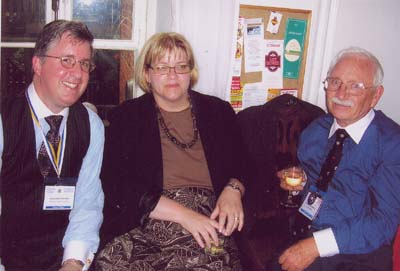
Bruce
Patterson, Canada; Claire Boudreau, Canada; Frederick Brownell, South
Africa
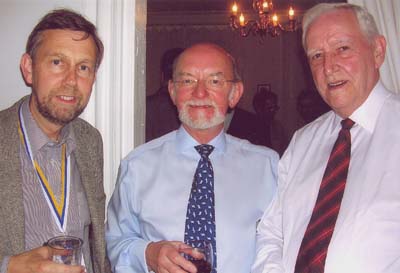
Adrian
Ailes, England; Charles Burnett, Scotland; Neil Fraser, Canada

Robb
Watt, Canada; Bruce Durie, Scotland; James Floyd, Scotland

Bruce
Patterson, Canada; D’Arcy & Kathleen Boulton, U.S.A.
Marie
attended the genealogical presentation entitled “To Lie like a
Genealogist” by John G. Crowley, from Georgia, U.S.A. who explored some
of the stories handed down in his family, suggesting descent from
British Royalty. After doing considerable research on his own and
having DNA tests done on the male members of his family, he discovered
that one of his ancestors was illegitimate - so much for family
traditions!
Another
genealogical lecture Marie attended was “Des Écossais au Canada et
jusqu’à Québec”, by Jeannine Ouellet, who referenced many famous Scots,
including some Frasers.

The
presentations on heraldry included:
Norway: Probably the World’s Most Exploring Nation Comparing to the
Population. Has It Any Exploration Heraldry? - by Tom S. Vandholm,
Norway. An amusing paper about the immense role of Viking explorers,
including those who had such an influence on the British Isles,
especially Scotland. He took delight in stating that, contrary to
popular legend, Viking helmets DID NOT have horns.
Le
dragon dans l’art héraldique, ou la quête de l’expression symbolique
conjointe du <Mal> et du <Bien> - by Alireza Taheri, Iran. (Missed
that one)
Conquête et reconquête héraldique coloniale et postcoloniale en Afrique
- by Rolf Sutter, Stuttgart, Germany. The presentation was in German,
with simultaneous translation into French, so I listened to it in German
and, surprisingly, understood more than I expected, or might have
understood in French.
The
Use of Colours and Emblems by Minority Groups in Bi-national or
Multinational States - by Bruce Patterson, Saint Laurent Herald and
Registrar at Canadian Heraldic Authority. Bruce explained the many
ethnic, religious and Aboriginal symbols used by Heralds at CHA in
devising an achievement of arms, personal, corporate, institutional or
religious in nature as charges on the shield, helm, as a crest and, if
granted, supporters and the compartment upon which the supporters
stand. The range included traditional symbols from European, English,
Scottish and Canadian Aboriginal sources (a first for Canada) that allow
Canadian heraldry to reflect the many ethnic origins in a multi-cultural
country like Canada.
The
Arms of Sir Francis Drake - by Dr. Charles Drake, Georgia, U.S.A.
Dr. Drake
explained his extensive research into the origin of arms granted to Sir
Francis Drake by Queen Elizabeth I of England (through the College of
Arms) and subsequent controversy when he claimed identical arms already
borne by another Drake family in England.
Heraldic Symbols on the Coats of Arms of the Military Aristocracy as
Vehicles for Memories of Struggles against the Ottomans - by Matea
Brstilo Resetar, Croatia.
The
Quest of a New Identity – Exemplified by Two Croatian Armorials - by
Peic Caldarovic Dubravka, Croatia.
Wladyslaw II Jagiello: Heraldry, Royal Power and the Union of Poland and
Lithuania 1386-1434 - by George Lucki, Edmonton, Alberta.
Not
being fluent in Croatian, and having a conflicting appointment, we
missed the last three sessions of Tuesday June 24th.
Wednesday was devoted to a selection of guided tours of Quebec City and
area and the opening of the Exhibit Hall for the Conference. Here is a
sampling of photos.
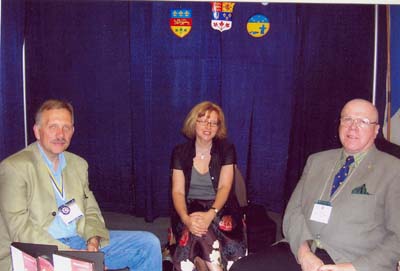
George
Lucki, Canada; Ilona Jurkiewicz, President of Toronto Branch, RHSC;
Peter Hogan, President of Laurentian Branch, RHSC
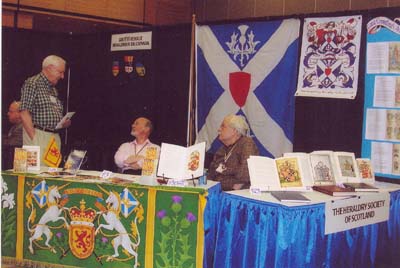
Neil
Fraser, Canada; Charles Burnett, Scotland; Mark Dennis, Scotland
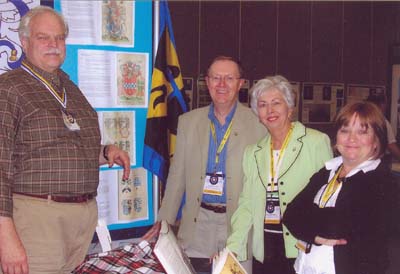
Mark
Dennis explaining Tartan to Quebec genealogy officials
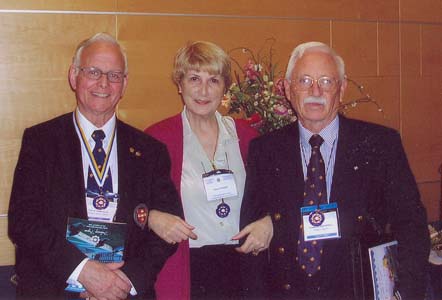
Tom. S.
Vadholm, Norway; Marie Fraser, Canada; Frederick Brownell, South Africa
The
Quest for Design Effectiveness: Lessons Learned from Emblems and Logos
- by Cathy Bursey-Sabourin, Fraser Herald and Principal Artist CHA and
by Dr. Claire Boudreau, Chief Herald of Canada, both from Ottawa,
Ontario. Cathy gave a power point visual presentation of commercial
logos, both good, and bad, often used as a substitute for a traditional
coat of arms. Some of the logos illustrated left much to be desired in
conveying a clear message of what they were intended to mean, although
the cost of design for a commercial logo far exceeds the cost of a well
designed heraldic achievement. Dr. Boudreau explained the process
followed by CHA in design of a full heraldic achievement, including the
appropriate blazon (legal description), painting of the final design and
calligraphy for the actual Letters Patent (in both English and French)
that is presented to the petitioner when completed.
The
Canadian Public Register: Evidence of a Systematic Evolution from
Passive Repository to Proactive Register - by Darrel Kennedy,
Assiniboine Herald at CHA.
Darrel
explained the transition of the Public Register of Arms, Flags and
Badges of Canada from the era prior to establishment of the Canadian
Heraldic Authority in 1988 when arms granted to a Canadian by the
College of Arms in England, the Court of the Lord Lyon King of Arms in
Scotland, the Chief Herald of Ireland and other recognized foreign
heraldic authorities could be registered for use in Canada. After 1988
arms granted to Canadian Citizens through Canadian Heraldic Authority
have been recorded in the Public Register and the grant reported in the
Canada Gazette to protect the copyright of the armiger.
The
Effect of the English ‘Conquests’ on the Armory and Heralds of Scotland
- by Charles Burnett, Ross Herald of Arms, Court of the Lord Lyon in
Scotland and President, The Heraldry Society of Scotland. Charles
explained the different history of heraldry between Scotland and England
prior to the Union of Crowns in 1603; following the Union of Crowns when
the College of Arms tried to exert its influence on Scotland
under James I of England and VI of Scotland; following the Union of
Parliaments in 1707 and how the influence of the College of Heralds has
often conflicted with the Lord Lyon in Scotland. The presentation was
light-hearted as Charles used his Scots accent and dry sense of humour
to advantage. One example was when he showed the early Union Flag
incorporating the blue and white Saltire of Scotland overlaid by the
white flag with the Red Cross of St. George for England. The Scots
response was a Union Flag with the Scots Saltire overlaying the English
Flag making it appear much different from the Union Flag of today.
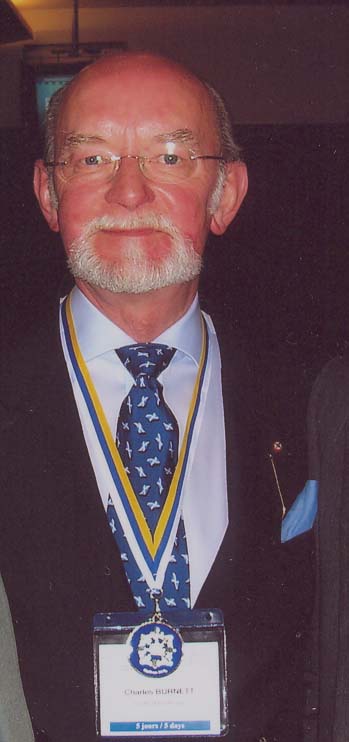
L’augmentation aux armes des frères Kirke; commémoration héraldique
d’une conquête - by Robert Pichette, New Brunswick, Dauphin Herald
Extraordinary, Canadian Heraldic Authority.
Terra Incognita: The Influence of New World’s Symbols in Spanish 16th
Century’s Heraldry - by Rodrigo Lopez Portillo Y Lancaster-Jones,
Mexico.
L’Héraldique dans les peintures murales commémoratives des conquêtes de
la couronne d’Aragón - by Leticia Darna, Spain.
We
missed the last three morning lectures due to a prior luncheon
appointment in Quebec City. (Shame on us)
The
Motto Flourishes - by Alex Maxwell Findlater, Scotland, HSS
Committee Member. Alex explored the various mottoes in the arms of his
Maxwell ancestors from the 16th to the 19th
century due to conflicting claims to a motto by some Maxwells.
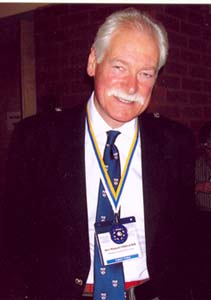
Heraldry and the Postage Stamps of Israel: Missed Opportunites? - by
Beverly Bergman, England.
The
Westford Knight: Heraldic Evidence of pre-Columbian Scottish Explorers
in America - by David Appleton of Texas, U.S.A. An exploration of
the rock carvings of heraldic symbols found in New England suggesting
that Scots had visited the area 100 years before Christopher Columbus
‘discovered’ North America, and the authenticity of such evidence.
The
Scottish Merchants: Three Centuries of Heraldic History - by Prof.
James Floyd, Scotland, Editor of Tak Tent and The Double Tressure,
newsletter and Journal of The Heraldry Society of Scotland. Prof. Floyd
explained the many symbols of the New World incorporated into the arms
(often assumed rather than granted) of Scottish merchants trading in the
West Indies and the American Colonies, primarily in the sugar and
tobacco trade where many great fortunes were made and often used to
build elaborate country homes in Scotland.

Armoiries et sceaux des nations étrangères à Bruges, du 13e au 16e
siècle - by André Vandewalle, Bruges, Belgium. An illustrated
explanation of the influence of many countries represented in commerce
in Belgium through incorporation of their national heraldry in buildings
and attempts to preserve many of the foreign style buildings, not always
successfully.
The
Lyon in Empire: The impact of the British Empire on Scottish Heraldry,
ca. 1600-1900 - by Mark D. Dennis, Chairman, The Heraldry Society of
Scotland, Heraldic Artist, Solicitor and Immigration Court Judge in
Edinburgh. Born in San Francisco, U.S.A. to Canadian-born parents, Mark
Dennis has been a resident of Scotland for many years. Mark is a large
man with a booming voice and his talk was laced with dry humour in
explaining the often conflicting approaches to heraldry in England and
Scotland, much to the amusement of the audience.

Signs of Cultural Continuity and Imperial Unity: The Adoption (and
Rejection) of Affiliative Symbols in the Jurisdictional and Corporate
Arms of North America, 1606-2002 - by Jonathan D’Arcy Boulton,
Professor of Medieval Studies, Notre Dame University, South Bend,
Indiana, U.S.A. Prof. Boulton is a Canadian who now teaches in the U.S.
and is a noted expert on heraldry and long-time member of the Royal
Heraldry Society of Canada where he is a member of the Advisory
Committee of the College of Fellows. I know D’Arcy well and kidded him
prior to his talk that, having read the title of his presentation, I
didn’t need to actually hear it. In fact, we did sit through the entire
presentation which proved to be well-researched and more interesting
than we expected, even if D’Arcy had to be asked to finish early, to
keep things on schedule, as he does tend to elaborate, at times.
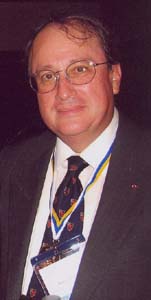
In
the Queen’s Name – Heraldic Sovereignty in the Realms and Territories of
HM Elizabeth II - by James Terzian, U.S.A.
Johann Moritz von Nassau-Siegen, donateur d’armoiries au Brésil - by
Rolf Wilhelm Nagel, Duisburg, Germany.
Signs, Seals and Symbols of Colonial Power 1600-1960: A View from H.M.
Government - by Adrian Ailes, England.
One
Defends and the Other Conquers: The Uses of Native Symbolism in North
American Heraldry - by Jonathan Good, Georgia, U.S.A. Jonathan is a
Canadian who is now a Professor of History at a university in Georgia,
and edits Gonfannon, the newsletter of the Royal Heraldry Society of
Canada.
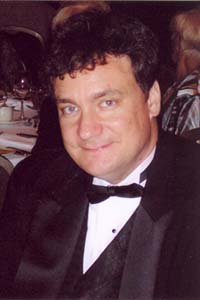
Friday
evening was devoted to the closing banquet, held at the Chateau Laurier
Hotel, a considerable walk from the Quebec Hilton where we were staying
and, along with a number of others wearing the kilt and formal Highland
wear, quite an adventure to be walking the streets of Quebec City and
terrifying the French Canadian population that the Scots might be
returning to complete the job they started on the Plains of Abraham in
September 1759.
Each
table was devoted to one of the Filles du Roi (Daughters of the King)
who arrived from France as brides to help populate the Colony. Our
table was named for Anne Perrault. Here is a sampling of photos from
the reception and banquet.

Frederick Brownell, South Africa; Neil Fraser, Canada; Beverly Bergman,
England

Bruce
Patterson, Canada; Kathy Bursey-Sabourin, Canada; Adrian Ailes, England;
Rolf Sutter, Germany

Donald
& Betty Draper Campbell, U.S.A; Neil Fraser, Canada
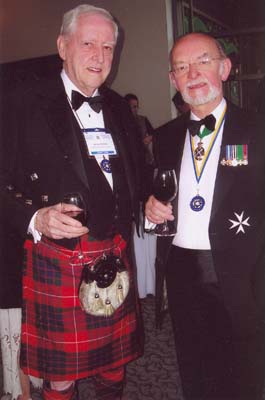
Neil
Fraser, Canada; Charles Burnett, Scotland

Mark
Dennis, Scotland; Donald Draper Campbell, U.S.A.
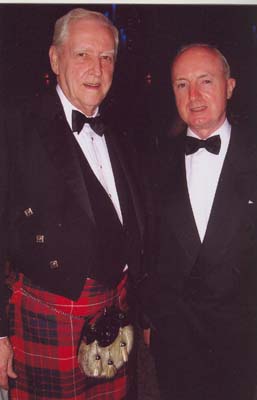
Neil
Fraser, Canada; Fergus Gillespie, Chief Herald of Ireland

Robb
Watt, Chief Herald of Canada 1988-2007; Bruce Patterson, Saint Laurent
Herald & Registrar CHA

Annemarie & Rolf Nagel, Germany; Ilona Jurkiewicz, Canada
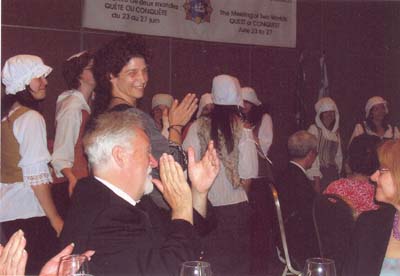
Filles
du Roi (Daughters of the King)
Her Excellency the
Right Honourable Michaëlle Jean
Speech on the Occasion of the Opening of the XXVIIIth Congress of
Genealogical and Heraldry Sciences
Québec, Monday, June
23, 2008
It is with great pride
that I welcome you to the magnificent city of Québec, a world heritage
jewel, particularly at this time when we are celebrating its 400th
anniversary.
From the heights of the
Citadelle to the streets of Lower Town, our history is everywhere before
our eyes and is revealed in the traces that time has left behind for our
collective enrichment.
I believe that we would
not be able to find a better location, nor a more auspicious occasion,
to hold this 28th International Congress of Genealogical and
Heraldic Sciences. All of you who are passionate about history and
appreciative of culture will find that there is much to see and discover
here.
For me, opening this
congress is a much more significant and consequential duty than simply
performing the task required of me as honorary patron of an event of
this calibre.
Genealogy and heraldry
are auxiliary sciences of history, and I believe that they have a
relevance and a remarkable necessity at the beginning of the third
millennium.
When I was named to the
post of governor general of Canada two and a half years ago, I had the
occasion, not to mention the privilege, to reflect on the path of my
life.
Haiti, the island of my
birth, had an oppressive and brutal regime that my family and I had to
flee before I was 10 years old. I then came to this land, where I have
set down root and which has become for me a country of endless
possibilities.
I have also looked back
in time to retrace the paths of my ancestors, which were uprooted from
Africa. They were transported like merchandise to this side of the
Atlantic and were reduced to a state of slavery, an experience shared by
some aboriginal people on their own land.
This reflection was an
internal voyage, a journey that has allowed me to better understand the
hope I embody for all those who, at some point, had to reclaim their
freedom.
In my duty as head of the
Canadian Heraldic Authority, I had to create, in a few weeks, my
personal coat of arms, which I shall transmit to my daughter, Marie-Éden
and to her descendants.
My arms reflect these
pathways. They are a symbol of my profound convictions, of what I hope
to accomplish over the course of my mandate, and of the heritage that I
would like to leave to the country that has opened its arms and its
heart to me.
“Breaking down the
solitudes” is the motto I have chosen.
It provides a wonderful
link to the theme of the congress—The meeting of two worlds: quest or
conquest. I believe that Canada has become what it is today because it
has never ceased to count on the infinite possibilities that can stem
from the meeting of people coming from all over the world to participate
in the ideal of a pluralist society where each person enjoys equal
rights.
This year, my husband,
Jean-Daniel Lafond, also created his coat of arms which I saw for the
first time only two weeks ago.
For him, as for me, this
has been a magical, deeply moving and unforgettable experience.
In a way far more
profound than we had initially expected, we were following in the
footsteps of others who had taken the journey before us.
His motto says a lot
about him as a philosopher, a film-maker and a man profoundly engaged in
joining me in this great adventure: “Humanity for one’s homeland”. This
is another wonderful legacy for our daughter Marie-Éden; for Estelle and
Élise, from his first marriage; and our two granddaughters, Éléonore and
Justine. Nothing is more precious than passing on to our children our
world-view on which they will be able to reflect.
Certainly, this has been
an exercise that one cannot enter into lightly, and which requires total
involvement. Because to choose the elements of an emblem–regardless of
its type–some fundamental questions need to be asked.
Who are we?
How do we express in
symbols our roots, our history, and our values?
How do we ensure that the
proposed message is at the same time powerful, meaningful and
æsthetically?
How do we express the
essence of our family or of our society and the place we hold in it?
How, finally, do we
succeed at this endeavour while respecting the rules of blazonry,
because nothing in a coat of arms is left to chance, and because each
colour and charge carries the message that we choose to give it.
My husband and I were
able to count on the heralds of arms of Canada to aid us in this
process.
They allowed us to
discover their passion and their discipline.
They convinced us of the
evocative power of coats of arms and of their importance to expand our
understanding of ourselves and of the world and to assure continuity in
this era of instant gratification.
Today, I would also like
to salute their expertise, and to express my pride that a woman–and a
very capable woman–Claire Boudreau, is in charge of the Canadian
Heraldic Authority.
Genealogy was born of a
desire to know who one is and from where one has come, in order to
project oneself into the future.
It is a pastime, but it
is also a science that for the last quarter century has undergone a
rebirth in many countries.
My curiosity and my
enthusiasm concerning my own history are likely quite similar to those
of the descendants of the first settlers who came to Canada.
This enthusiasm is
something also shared by members of the First Nations, the Métis and the
Inuit communities, who are as committed as always to preserving their
cultures, languages and the knowledge of their elders and their
ancestors.
These are universal
needs.
Now, the desire to know
who one is can lead us to advanced genealogical research that requires
training in new skills in order to read and interpret primary sources
and old documents in the archives.
This highlights the
importance of your role, of your knowledge, and, as I said, of your
passion. You are renowned experts in your field, and the program of this
congress bears witness to this. I encourage you to make the most of the
occasion to discover the studies and specialities of your colleagues who
have come here, to Québec, to share the results of their research.
This year, the Canadian
Heraldic Authority is celebrating its 20th anniversary. In
spite of the distance, and as much as possible, the Authority
contributed with great pleasure to the monumental task which the
organizers of the congress had undertaken.
In 1996, this same
congress took place in Ottawa, and the heralds have told me of the
considerable work and of the time required to organize such a meeting.
Allow me to congratulate
the Fédération des Sociétés de généalogie du Québec and the Société de
généalogie de Québec for their generosity, their enthusiasm and their
professionalism.
Many volunteers from
these organizations will be on duty all week. Their dedication deserves
to be acknowledged and warmly applauded.
In closing, I would like
to invite you this Saturday, June 28, in the afternoon, to an open house
at the Citadelle, which is the second official residence of the governor
general. Several exhibits on the 400 years of history of the city of
Québec will be presented. I look forward to seeing you there.
May these five days in
Québec be filled with happy meetings and fortunate discoveries. Have a
great congress.
Coat of Arms of Her
Excellency the Right Honourable Michaëlle Jean Governor General of
Canada
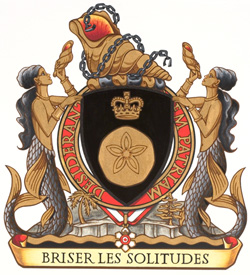 In
the centre of the coat of arms is a sand dollar, which is a special
talisman for Michaëlle Jean. Sand dollars are marine creatures found on
both the Atlantic and Pacific coasts of Canada and Northern United
States. The Royal Crown symbolizes the vice-regal function and service
to all Canadians. Above the shield, the sea shell and broken chain
allude to the famous sculpture Marron inconnu by Albert
Mangonès, displayed in Port-au-Prince, Haiti, depicting an escaped slave
blowing a sea shell to gather and call to arms his fellow sufferers
around the whole island. For Michaëlle Jean this image evokes the
victory of her ancestors over barbarism and, more broadly, the call to
liberty. Beside the shield are two Simbis, water spirits from Haitian
culture who comfort souls, purify troubled waters and intervene with
wisdom and foresight. Moreover, the Simbis' words are enlightening and
soothing. These two feminine figures symbolize the vital role played by
women in advancing social justice. They are shown in front of a rock set
with a palm tree, a symbol of peace in Haitian history, and a pine tree
representing the natural riches of Canada. The motto Briser les
solitudes, which means "Breaking down solitudes", is at the heart
of the objectives Michaëlle Jean intends to follow. An annulus inscribed
with the motto of the Order of Canada, DESIDERANTES MELIOREM PATRIAM (they
desire a better country), encircles the shield, and the insignia of
a Companion of the Order of Canada is suspended from the shield. In
the centre of the coat of arms is a sand dollar, which is a special
talisman for Michaëlle Jean. Sand dollars are marine creatures found on
both the Atlantic and Pacific coasts of Canada and Northern United
States. The Royal Crown symbolizes the vice-regal function and service
to all Canadians. Above the shield, the sea shell and broken chain
allude to the famous sculpture Marron inconnu by Albert
Mangonès, displayed in Port-au-Prince, Haiti, depicting an escaped slave
blowing a sea shell to gather and call to arms his fellow sufferers
around the whole island. For Michaëlle Jean this image evokes the
victory of her ancestors over barbarism and, more broadly, the call to
liberty. Beside the shield are two Simbis, water spirits from Haitian
culture who comfort souls, purify troubled waters and intervene with
wisdom and foresight. Moreover, the Simbis' words are enlightening and
soothing. These two feminine figures symbolize the vital role played by
women in advancing social justice. They are shown in front of a rock set
with a palm tree, a symbol of peace in Haitian history, and a pine tree
representing the natural riches of Canada. The motto Briser les
solitudes, which means "Breaking down solitudes", is at the heart
of the objectives Michaëlle Jean intends to follow. An annulus inscribed
with the motto of the Order of Canada, DESIDERANTES MELIOREM PATRIAM (they
desire a better country), encircles the shield, and the insignia of
a Companion of the Order of Canada is suspended from the shield. |
